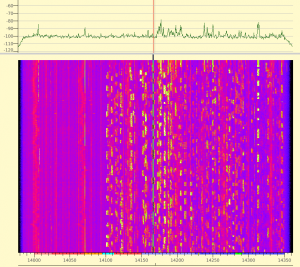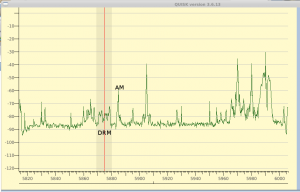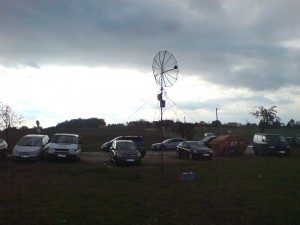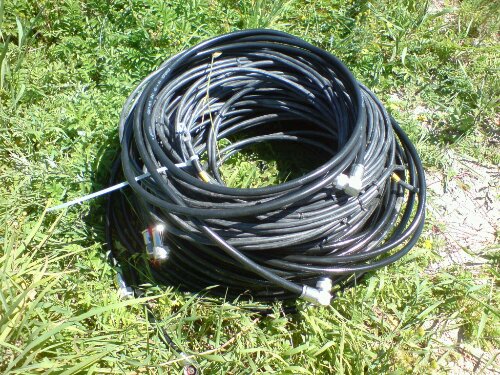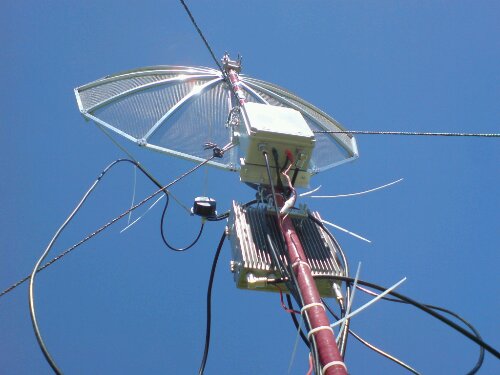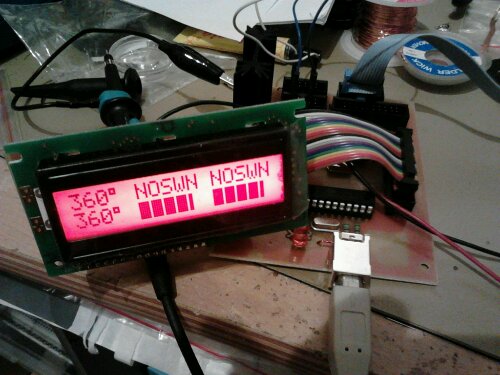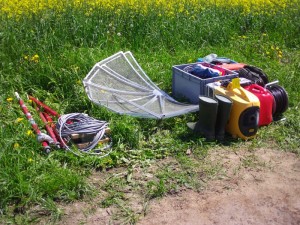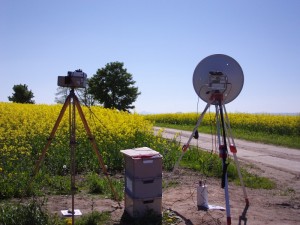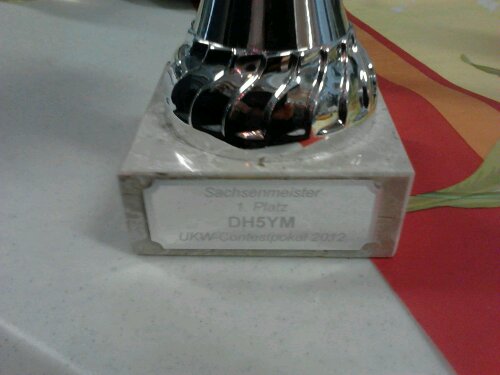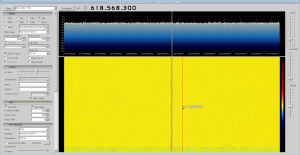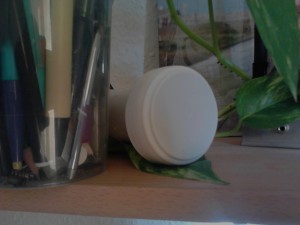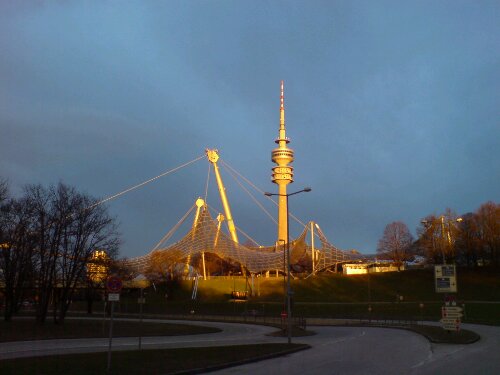During the weekend i made a few 10m QSO in the CQ-WW-SSB contest. In the evening i took the following screenshots of 20/40/80m.
KBS from Sofia in DRM/AM Simulcast
The korean national service KBS is currently testing DRM-AM simulcast. This means the same service is transmitted side by side on co channels. One channel contains the service broadcasted in DRM mode, the next channel contains the same service via AM. This gives the opportunity for some nice comparisons between DRM and AM stability and audio quality. Find two audio snippeds below.
The transmissions will be every evening from 19UTC to 20UTC on 5875kHz (DRM) and 5885kHz (AM) – source www.drm.org
The screenshot shows a part of the radio band yesterday evening. Unfortunately the conditions to Sofia had been really poor. You can see the both signals of KBS and some much stronger signals from other broadcasters.
Obviously the DRM signal was suffering from sideband lobes falling into the DRM spectrum limiting the SNR because at the end when the modulation was already switched off the DRM SNR increased rapidly.
Voice audio snipped – first DRM, then switching to AM
Music audio snipped – first DRM, then switching to AM
The DRM audio was transmitted in AAC+ Mono with 18kBit/s. It gives a rather nice sound compared to other DRM broadcasts that can be received at the moment.
DUR activity 2013 October
After 2 month of inactivity from my side another trial with 3 bands. I had 23/13/9cm with my 1.5m dish.
Meanwhile i integrated the 5W PA for 9cm. This time Murphy tried to do its very best.
I had to tear down the antenna 3 times in between. First i had troubles to find the correct lengths of the ropes for the mast.
When testing the transverters i experienced 9cm was not switching to TX. During my mast trouble i accidently disconnected the 9cm power cable at the mast unit.
After that operation was going relatively smooth. This time i was heard very well by the others on 9cm. But i experienced that my RX seems to be really poor. I always gave much better reports than i got. I did not check the sensitivity so far. Everything you dont check will not work ;)
In the end i had 17 QSO on 23cm, 9 QSO on 13cm, 5 QSO on 9cm.
ODX on 23cm was HA5UA/p. Thanks for the patience during that weak signal QSO.
Next steps with improving my setup will be a new rotator control. The original KR600 controler has some issues and i somethimes do not get correct heading. 23cm would need to be mounted to the mast. Unfortunately i dont think that i can get the mast up then. It would be too heavy.
Back with new URL…
The blog was off for some days because of vacation. After returning i noticed that dyndns completely discontinued the free service even for old accounts and since i did not want to pay 25$ to go back to ath.cx i decided to move to no-ip. Now the new URL will stay dh5ym.hopto.org as long as possible.
July DUR Contest
DL1DBR Rotator Contol Unit
DUR Contest May & WebSDR
This time DUR contest together with Steffen DJ5AM.
QRV on 23cm, 13cm, 10GHz, partly 24GHz.
Not very much DX on 23cm this time but some nice 10GHz QSO with the station of Steffen.
I made a short video receiving my 23cm signal with the WebSDR located at my home QTH.
The WebSDR is a test and receives 23cm & as well as 10GHz using 2x RTLSDR USB sticks.
PA3FWM kindly added support for these types of USB receiver sticks which makes it very easy to setup WebSDR receivers for the bands between 24MHz and 1700MHz. One is connected to a crystal stabilized sat LNB which makes the receiver for the narrow band section of the 10GHz ham band.
As long as the receiver is online you can find it here:
http://dh5ym.hopto.org:8901
The following pictures show my 23/13cm equipment after then end of the DUR test ready to go home and the 10GHz and 24GHz station of Steffen, DJ5AM.
…
Low cost 10GHz reception
Some days ago i found a nice video clip from an italian guy who used a cheap DVB-T stick (RTLSDR) in combination with a crystal stabilized sat-TV LNB for some 10GHz hamradio experiments.
A short search brought up a nice paper about some investigations of G4JNT who investigated the frequency stability and phase noise of one of such LNBs and found that it could be used for narrow band reception in amateur service. It can be found here: http://www.g4jnt.com/PLL_LNB_Tests.pdf Since i already have some experience with the RTLSDR stuff and currently experimenting with 10GHz as well i decided to give this ultracheap setup a chance. I purchased a LNB (which was told to have crystal stabilization) for about 7 Euro and made a phantom feed for that. With just the 12V applied to the coaxial cable it works in the lower band and the polarization is in the direction of the antenna connector. 10386MHz falls to about 618MHz since there are no sharp filters inside the LNB it is possible to receive some ham signals.
The picture shows the reception of the local beacon DM0TUD. Its not very strong here since it comes in via reflection at the other side of the city. With my 60cm dish its about S8. The LNB i use without any dish just placing it onto the cupboard.
Find here a short video that give an impression how it sounds like.
https://www.youtube.com/embed/SJlcb0t2GGw
The signal sounds a bit ugly because of the LNBs oscillator phase noise. The frequency of the LNB was quite stable after half an hour of operation. The LNB was just lying on the cupboard and used as it is without any dish. I have no direct line of sight to the beacon and i receive the signal just via reflection at the other end of the city. Therefore you can notice some fading.
Edit: When opening the LNB i found that it has DROs and not as advertized on the package a crystal stabilized oscillator. For DROs its working quite well but since its stated even on the package that it should be “crystal controlled” its obviously a fake.
Edit 2: Today i received another LNB. Its a Octagon Optima model OTLSO as measured by G4JNT. I made a new video of the reception of the DM0TUD 10GHz beacon under the same conditions as before. The sound is perfectly fine now.

